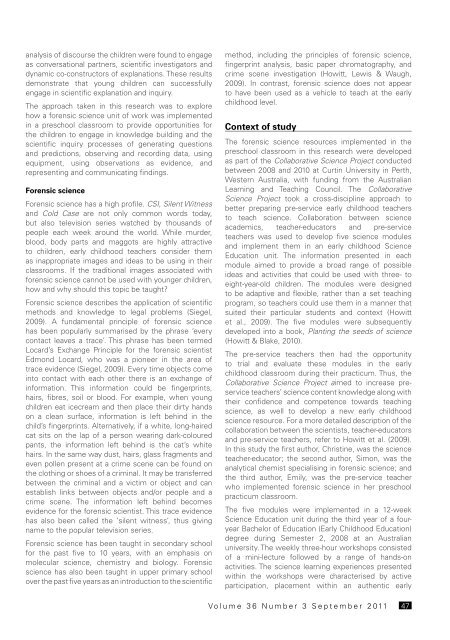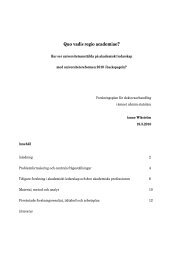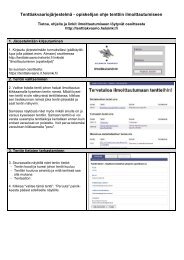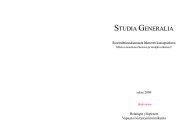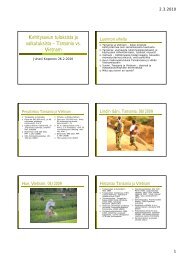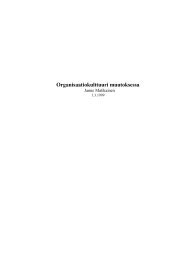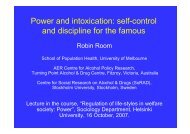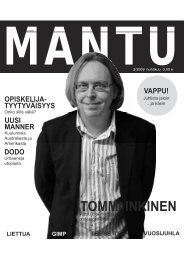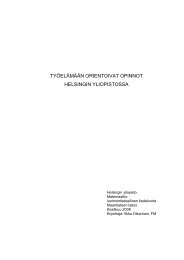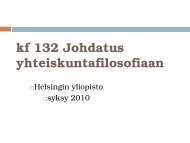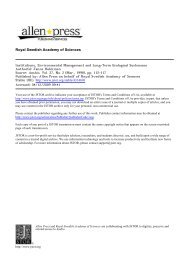who question the value and place <strong>of</strong> science (Fleer,2009a), with a subsequent lack <strong>of</strong> suitable role modelsfor observing effective science teaching and learningin the early childhood years (Skamp & Mueller, 2001).The purpose <strong>of</strong> this paper is to present a detailedcase study <strong>of</strong> how a pre-service teacher implementedforensic science within a preschool (four-year-old)classroom as a form <strong>of</strong> guided scientific inquiry. It notonly highlights how a complex topic can be modified forpreschool, but how young children can readily engagein inquiry-based learning. The first part <strong>of</strong> this paperintroduces inquiry learning, and the important place<strong>of</strong> such learning in science. The fundamental principle<strong>of</strong> forensic science, along with the current image <strong>of</strong>forensic science in school education, is then described.Following this, the context <strong>of</strong> the study positions thispaper within a wider research project. The paper thenintroduces the case study research design, and presentsand discusses the findings from the case study whereforensic science was implemented in the preschoolclassroom. The paper concludes with a discussion <strong>of</strong>the sociocultural context <strong>of</strong> learning, highlighting theconnection between everyday concepts and scientificconcepts within the forensic science program.Science as a sociocultural practiceIn this paper, science learning is viewed as sociallynegotiated and situated in specific contexts andpractices. Such a sociocultural approach to learningacknowledges the place <strong>of</strong> personal, social and culturalaspects in children’s learning and the interactionbetween individuals, social groups and contexts(Robbins, 2005). Additionally, sociocultural practices<strong>of</strong> science acknowledge that learning occurs throughthe co-construction <strong>of</strong> ideas, sharing <strong>of</strong> knowledge,modification <strong>of</strong> ideas and knowledge, and consensus<strong>of</strong> the interpretation <strong>of</strong> data (Samarapungavan,Mantzicopoulos & Patrick, 2008).Inquiry-based learningContemporary learning theory states that learning ismost effective when students are active participantswithin the learning process, when the learning proceedsfrom experiences to explanations, when students’existing knowledge is used as the platform to developnew explanations, and when teachers are prepared tosupport students in the learning process (Anderson,2002; Hackling, 2007). An inquiry-based approachto learning, where students are actively involved infinding answers to their own questions, incorporatesall <strong>of</strong> these conditions. Learning science through aninquiry approach involves students in asking questions,exploring and investigating phenomena through themanipulation <strong>of</strong> materials, gaining experiences andmaking observations, and then developing explanationsfor those experiences (Hackling, 2007). At the heart <strong>of</strong>inquiry-based learning is the student trying to makesense <strong>of</strong> the phenomena under study (Crawford, 2009).As such, this approach actively engages studentsin learning, encourages curiosity and excitement <strong>of</strong>discovery, develops knowledge and understanding<strong>of</strong> scientific ideas, supports students in using data asevidence, and allows students to experience workinglike a real scientist (Anderson, 2002; Crawford, 2007).Within early childhood education, inquiry learningappears to commonly follow that <strong>of</strong> guided inquiry. Aguided inquiry approach provides structured experiences<strong>of</strong> the phenomenon and leads to the collection <strong>of</strong>observations that can be used to develop explanationsfor the phenomenon (Hackling, 2005). Guided inquirytherefore involves guided and collaborative participation(Hedges, 2000) between the teacher and childrenthrough steps that may involve manipulating materials;making observations or measurements; or recording,discussing or interpreting observations (Hackling, 2005).Guided participation acknowledges the role <strong>of</strong> childrenas ‘active agents and communicators in their ownlearning’ (Hedges, 2000, p. 18).One <strong>of</strong> the key issues in guided inquiry is to select anappropriate context and learning experiences that allowyoung children to create meaningful new knowledge,based on the cognitive resources they bring to thetask (Samarapungavan et al., 2008). These authorsfurther commented on the need to provide appropriateinstructional support, as young children are ‘universalnovices’ (p. 903), lacking experiences with science asa discipline as well as having limited cognitive toolsfor literacy and numeracy. Such support includedmodelling aspects <strong>of</strong> inquiry, guiding science discourse,and assisting young children to better understand thescientific inquiry process (Samarapungavan et al., 2008).There appears to be limited research on the outcomes<strong>of</strong> inquiry learning on young children. However, a fewrelevant studies were located. Samarapungavan et al.(2008) examined United States kindergarten (no agegiven) children’s science learning, using a guided inquiryapproach into the life cycle <strong>of</strong> the monarch butterfly.Their results indicated that kindergarten children wereable to successfully engage in the practices <strong>of</strong> scientificinquiry and to conduct empirical investigations to extendand revise their biological knowledge. As measuredthrough an analysis <strong>of</strong> portfolios, they found thechildren were highly pr<strong>of</strong>icient in generating questions,making predictions, observing and recording data, andcommunicating their findings, while pr<strong>of</strong>icient in usingempirical evidence to extend, elaborate or revise theirknowledge. Also in the United States, Peterson andFrench (2008) examined preschool (three- and four-yearold)children’s explanatory language through scienceinquiry in a five-week unit on colour mixing. Through46A u s t r a l a s i a n J o u r n a l o f E a r l y C h i l d h o o d
analysis <strong>of</strong> discourse the children were found to engageas conversational partners, scientific investigators anddynamic co-constructors <strong>of</strong> explanations. These resultsdemonstrate that young children can successfullyengage in scientific explanation and inquiry.The approach taken in this research was to explorehow a forensic science unit <strong>of</strong> work was implementedin a preschool classroom to provide opportunities forthe children to engage in knowledge building and thescientific inquiry processes <strong>of</strong> generating questionsand predictions, observing and recording data, usingequipment, using observations as evidence, andrepresenting and communicating findings.Forensic scienceForensic science has a high pr<strong>of</strong>ile. CSI, Silent Witnessand Cold Case are not only common words today,but also television series watched by thousands <strong>of</strong>people each week around the world. While murder,blood, body parts and maggots are highly attractiveto children, early childhood teachers consider themas inappropriate images and ideas to be using in theirclassrooms. If the traditional images associated withforensic science cannot be used with younger children,how and why should this topic be taught?Forensic science describes the application <strong>of</strong> scientificmethods and knowledge to legal problems (Siegel,2009). A fundamental principle <strong>of</strong> forensic sciencehas been popularly summarised by the phrase ‘everycontact leaves a trace’. This phrase has been termedLocard’s Exchange Principle for the forensic scientistEdmond Locard, who was a pioneer in the area <strong>of</strong>trace evidence (Siegel, 2009). Every time objects comeinto contact with each other there is an exchange <strong>of</strong>information. This information could be fingerprints,hairs, fibres, soil or blood. For example, when youngchildren eat icecream and then place their dirty handson a clean surface, information is left behind in thechild’s fingerprints. Alternatively, if a white, long-hairedcat sits on the lap <strong>of</strong> a person wearing dark-colouredpants, the information left behind is the cat’s whitehairs. In the same way dust, hairs, glass fragments andeven pollen present at a crime scene can be found onthe clothing or shoes <strong>of</strong> a criminal. It may be transferredbetween the criminal and a victim or object and canestablish links between objects and/or people and acrime scene. The information left behind becomesevidence for the forensic scientist. This trace evidencehas also been called the ‘silent witness’, thus givingname to the popular television series.Forensic science has been taught in secondary schoolfor the past five to 10 years, with an emphasis onmolecular science, chemistry and biology. Forensicscience has also been taught in upper primary schoolover the past five years as an introduction to the scientificmethod, including the principles <strong>of</strong> forensic science,fingerprint analysis, basic paper chromatography, andcrime scene investigation (Howitt, Lewis & Waugh,2009). In contrast, forensic science does not appearto have been used as a vehicle to teach at the earlychildhood level.Context <strong>of</strong> studyThe forensic science resources implemented in thepreschool classroom in this research were developedas part <strong>of</strong> the Collaborative Science Project conductedbetween 2008 and 2010 at Curtin University in Perth,Western Australia, with funding from the AustralianLearning and Teaching Council. The CollaborativeScience Project took a cross-discipline approach tobetter preparing pre-service early childhood teachersto teach science. Collaboration between scienceacademics, teacher-educators and pre-serviceteachers was used to develop five science modulesand implement them in an early childhood ScienceEducation unit. The information presented in eachmodule aimed to provide a broad range <strong>of</strong> possibleideas and activities that could be used with three- toeight-year-old children. The modules were designedto be adaptive and flexible, rather than a set teachingprogram, so teachers could use them in a manner thatsuited their particular students and context (Howittet al., 2009). The five modules were subsequentlydeveloped into a book, Planting the seeds <strong>of</strong> science(Howitt & Blake, 2010).The pre-service teachers then had the opportunityto trial and evaluate these modules in the earlychildhood classroom during their practicum. Thus, theCollaborative Science Project aimed to increase preserviceteachers’ science content knowledge along withtheir confidence and competence towards teachingscience, as well to develop a new early childhoodscience resource. For a more detailed description <strong>of</strong> thecollaboration between the scientists, teacher-educatorsand pre-service teachers, refer to Howitt et al. (2009).In this study the first author, Christine, was the scienceteacher-educator; the second author, Simon, was theanalytical chemist specialising in forensic science; andthe third author, Emily, was the pre-service teacherwho implemented forensic science in her preschoolpracticum classroom.The five modules were implemented in a 12-weekScience Education unit during the third year <strong>of</strong> a fouryearBachelor <strong>of</strong> Education (<strong>Early</strong> <strong>Childhood</strong> Education)degree during Semester 2, 2008 at an Australianuniversity. The weekly three-hour workshops consisted<strong>of</strong> a mini-lecture followed by a range <strong>of</strong> hands-onactivities. The science learning experiences presentedwithin the workshops were characterised by activeparticipation, placement within an authentic earlyVo l u m e 3 6 N u m b e r 3 S e p t e m b e r 2 011 47
- Page 3 and 4: 1.5 Display, download or print the
- Page 5 and 6: Volume 36 Number 3 September 2011Jo
- Page 7 and 8: Curriculum guidelines for early lit
- Page 9 and 10: ■■Know that print carries meani
- Page 14 and 15: Korean children’s cultural adjust
- Page 16 and 17: The Early Years Learning Framework
- Page 18: Kyung Min said listening in class w
- Page 21 and 22: immediately impact on children’s
- Page 23 and 24: Child participation in the early ye
- Page 25 and 26: their kindergarten day. A study by
- Page 27 and 28: the overall organisation, routines,
- Page 29 and 30: Council of Australian Governments (
- Page 31: Learning to measure length in the f
- Page 34 and 35: ■■a 40-minute, one-on-one inter
- Page 36 and 37: ■■72 per cent of the project sc
- Page 38 and 39: In other words, the difficulties th
- Page 40 and 41: An analysis of New Zealand’s chan
- Page 42 and 43: Before five also gave equivalent st
- Page 44 and 45: some evidence that curriculum effec
- Page 46 and 47: achievement; aiding transition to s
- Page 49: ‘It’s a mystery!’A case study
- Page 56 and 57: ange of objects on the floor (such
- Page 58 and 59: Observation and recording informati
- Page 60 and 61: ‘I’m making it different to the
- Page 62 and 63: Purpose and theoretical frameworkIn
- Page 64 and 65: The fingers were reaching out acros
- Page 66 and 67: Figure 7. ‘I take this lovely lad
- Page 68 and 69: Here, Rachel used substitution to r
- Page 70: Evaluating the feasibility, effecti
- Page 73 and 74: Table 2. Descriptive characteristic
- Page 75 and 76: The children in this study were fro
- Page 77 and 78: Vol. 36 No. 3 September 2011Austral
- Page 79 and 80: implement the curriculum effectivel
- Page 81 and 82: Table 2. Mean differences between H
- Page 83 and 84: can be regarded as one of the infor
- Page 85 and 86: Ganser, T. (2000). An ambitious vis
- Page 87 and 88: (Buckhalt et al., 2009). Reduced qu
- Page 89 and 90: invited families having difficulty
- Page 91 and 92: Table 3. Mean hours of mother and f
- Page 93 and 94: A reduction in night wakings might
- Page 95 and 96: A preliminary exploration of childr
- Page 97 and 98: adult support necessary for its eff
- Page 99 and 100: Children’s cortisol and alpha-amy
- Page 102 and 103:
Connor, C., Son, S.-H., Hindman, A.
- Page 104 and 105:
Equity of access:Requirements of In
- Page 106 and 107:
excursions, which have been reporte
- Page 108 and 109:
We need a bus but we also need a st
- Page 110 and 111:
Appropriate child careIndigenous fa
- Page 112 and 113:
Australian Institute of Health and
- Page 114 and 115:
The Mosaic Approach relies on child
- Page 116 and 117:
participants (Altrichter, Posch, &
- Page 118 and 119:
distance. This involved trying to b
- Page 120 and 121:
Dockett, S., & Perry, B. (2003). Ch
- Page 122 and 123:
experiences (Bandura, 1997). Belief
- Page 124 and 125:
the curriculum while on their profe
- Page 126 and 127:
Exploring and evaluating levels of
- Page 128 and 129:
Level 2: Attending to feelingsThis
- Page 130 and 131:
This process to ensure coder stabil
- Page 132 and 133:
DiscussionStructured reflective pro
- Page 134 and 135:
Rock, T. C., & Levin, B. B. (2002).
- Page 136 and 137:
issues encountered in their caring
- Page 138 and 139:
pertaining to the impact and suppor
- Page 140 and 141:
Parents felt the policies involving
- Page 142 and 143:
and access suitable carers because
- Page 144 and 145:
Ievers, C. E., & Drotar, D. (1996).
- Page 146:
www.earlychildhoodaustralia.org.auE


